
FILM QUARTERLY
Scope & Guideline
Unveiling Insights in Film Studies
Introduction
Aims and Scopes
- Interdisciplinary Film Studies:
The journal publishes works that blend various fields such as cultural studies, sociology, history, and aesthetics, providing a multifaceted view of cinema and its cultural implications. - Global Perspectives on Cinema:
Film Quarterly emphasizes the importance of international cinema, exploring films from diverse cultures and contexts, and examining their influence on global film culture. - Critical Theory and Analysis:
The journal encourages contributions that engage with critical theories, including feminist, queer, postcolonial, and critical race theories, to analyze films and media. - Emerging Technologies and Media:
There is a focus on how new technologies impact filmmaking, distribution, and consumption of media, reflecting on the changes these technologies bring to the cinematic landscape. - Cultural and Historical Contexts:
The journal explores the historical and cultural contexts of films, looking at how they reflect and shape societal values and narratives.
Trending and Emerging
- Digital and Interactive Media:
With the rise of streaming platforms and interactive cinema, there is an increasing interest in how these mediums transform storytelling and audience engagement. - Post-COVID Film Culture:
The journal has begun to explore the implications of the COVID-19 pandemic on film production, distribution, and consumption, examining how the industry adapts to new realities. - Decolonizing Film Narratives:
There is a growing emphasis on decolonizing film narratives, particularly in relation to representation, power dynamics, and the histories of marginalized communities. - Environmental Concerns in Cinema:
Emerging themes related to environmental issues and climate change are being explored, focusing on how film can address and critique ecological crises. - Intersectionality in Film:
The journal has increasingly focused on intersectional approaches to film studies, examining how various identities (race, gender, sexuality) intersect in cinematic narratives and production.
Declining or Waning
- Traditional Film Criticism:
There has been a noticeable decline in articles that engage in conventional film criticism, suggesting a shift towards more theoretical and interdisciplinary analyses rather than straightforward reviews. - Focus on Classic Cinema:
Themes surrounding classic films and their historical significance seem to be waning, as the journal increasingly prioritizes contemporary works and emerging filmmakers. - Mainstream Hollywood Analysis:
Analysis of mainstream Hollywood films, once a staple in film studies, appears to be less frequent, with more emphasis placed on independent, international, and avant-garde cinema. - Genre Studies:
There is a decrease in articles specifically dedicated to genre studies, indicating a broader focus on thematic and theoretical discussions rather than strict genre classifications. - Celebrity Studies:
Explorations of celebrity culture and its impact on film are becoming less common, as the journal shifts towards examining more complex social and political issues within cinema.
Similar Journals
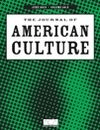
JOURNAL OF AMERICAN CULTURE
Exploring the Depths of American CultureJOURNAL OF AMERICAN CULTURE is a distinguished academic journal published by Wiley, focusing on the rich tapestry of American culture through various lenses including history, literature, visual arts, and cultural studies. Established in 1996 and continuing its scholarly contributions through 2024, the journal serves as a vital platform for researchers, professionals, and students to disseminate their work and engage with critical discussions surrounding American cultural narratives. With an impressive impact reflected in its 2023 quartile rankings — Q2 in Literature and Literary Theory and Q3 in Cultural Studies, History, and Visual Arts and Performing Arts — the journal enhances scholarly dialogue across diverse disciplines. Although it does not offer Open Access options, its rigorous peer-review process ensures high-quality research dissemination. It is a go-to resource for those aiming to explore the evolving dynamics of American culture within a global context.
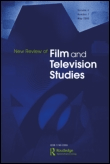
New Review of Film and Television Studies
Bridging Cultures Through Film and Television AnalysisNew Review of Film and Television Studies, published by Routledge Journals, Taylor & Francis Ltd, stands as a vital platform for scholars and practitioners engaged in the dynamic fields of film and television studies within the United Kingdom. This journal, which has been in circulation since 2010 and will continue through 2024, provides a rigorous academic forum for contemporary research, critical analysis, and innovative discourse surrounding visual storytelling. With an impressive Scopus rank placing it in the 66th percentile for Visual Arts and Performing Arts, and a respectable Q2 categorization, the journal fosters an interdisciplinary approach, bridging communication and cultural studies. While the journal does not currently operate under an open access model, it remains an invaluable resource for researchers, students, and professionals aiming to understand and influence the evolving landscape of film and television in our digital age. As it navigates the intersection of media and society, New Review of Film and Television Studies is essential reading for those looking to advance their knowledge and contribute to the ongoing scholarly conversation.
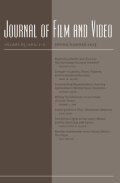
JOURNAL OF FILM AND VIDEO
Unveiling New Perspectives in Film and VideoThe JOURNAL OF FILM AND VIDEO, published by University of Illinois Press, is a pivotal academic platform that delves into the intricate intersections of film, video, and media studies. With a notable ISSN of 0742-4671 and E-ISSN 1934-6018, this journal has established itself as a significant contributor to the visual arts and performing arts field, currently positioned in Q3 of its category as per the 2023 quartiles. Spanning from 2002 to 2024, it presents a comprehensive array of research, critiques, and theoretical discussions that advance scholarly discourse in film and video. The journal encourages contributions that explore innovative narratives and methodologies, catering to a diverse readership of researchers, professionals, and students alike. While it maintains a traditional subscription model and is not open access, its impact is amplified through its Scopus ranking, holding the 323rd position out of 667 in the visual arts and performing arts category. With its commitment to fostering critical conversations and promoting scholarly excellence, the JOURNAL OF FILM AND VIDEO remains an essential resource for those invested in the study and understanding of film and media.
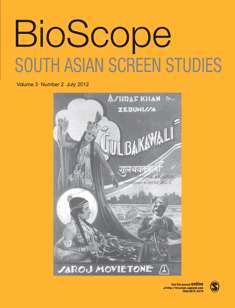
Bioscope-South Asian Screen Studies
Advancing Critical Dialogues in Screen StudiesBioscope-South Asian Screen Studies is an influential journal dedicated to advancing the field of screen studies in the South Asian context, published by SAGE Publications India Pvt Ltd. With an ISSN of 0974-9276 and an E-ISSN of 0976-352X, this journal spans a convergence of scholarly research from 2010 to 2024, providing a significant platform for interdisciplinary dialogue. Holding a Q3 rating in Communication and a Q2 rating in Visual Arts and Performing Arts in the 2023 category quartiles, it ranks 212th in its field on Scopus, reflecting its vital contribution to academic discourse. Bioscope aims to explore and critically analyze the rich tapestry of South Asian cinema, media, and performance arts, offering researchers, professionals, and students a valuable resource for deepening their understanding of regional and global cinematic narratives. Readers will find insightful articles that probe the cultural, social, and political dimensions of screen studies, making this journal an essential reference for anyone engaged in the evolving landscape of South Asian visual culture.

POSITIF
Celebrating Creativity: A Platform for Artistic ScholarshipPOSITIF is a distinguished journal, published by POSITIF EDITIONS, focusing on the dynamic fields of Visual Arts and Performing Arts. With ISSN 0048-4911, this journal has been a significant contributor to the arts community since its establishment in 2002, and it continues to captivate readers with its upcoming issues projected until 2024. Based in the heart of France at 12 RUE PIERRE ET MARIE CURIE, 75005 PARIS, POSITIF serves as an invaluable platform for researchers, professionals, and students alike, promoting innovative discourse and critical analysis within the arts. Despite holding a Q4 category ranking in the 2023 classification and a Scopus rank of 637/667, its commitment to enhancing the understanding and appreciation of visual and performing arts remains steadfast. Researchers are invited to contribute to this growing body of knowledge, enriching the journal's scope and impact in a vibrant artistic landscape.

SIGHT AND SOUND
Illuminating Film's Impact on SocietySIGHT AND SOUND is a prestigious journal published by the British Film Institute, dedicated to the exploration of cinema and its cultural significance. With an ISSN of 0037-4806 and an E-ISSN matching the same, this journal has been a critical platform for film studies since its inception, contributing valuable insights to the realms of visual arts and performing arts. Despite its discontinuation in the Scopus database post-2021, SIGHT AND SOUND commands respect within its field, currently holding a Q3 rank among Visual Arts and Performing Arts journals. Operating from 21 Stephen Street, London W1P 1PL, England, it serves as a vital resource for researchers, professionals, and students looking to deepen their understanding of film theory, critique, and history. While access to its articles is not open, the journal continues to influence the discourse in film studies, making it a significant asset in academic and professional circles.

Canadian Journal of Film Studies-Revue Canadienne d Etudes Cinematographiques
Bridging Canadian Perspectives with Global Cinematic PracticesCanadian Journal of Film Studies-Revue Canadienne d'Études Cinématographiques is a distinguished publication dedicated to the exploration of film studies within the context of Canadian cinema and global visual arts. Published by University of Toronto Press Inc., this journal offers a platform for innovative and critical scholarship, having achieved a notable Q2 ranking in the Visual Arts and Performing Arts category for 2023, with an impressive Scopus rank of 207 out of 667, positioning it in the 68th percentile among peers. With a continuous publication record since its established years from 1998 to 2001 and 2004 to 2024, it has become an essential resource for researchers, professionals, and students interested in the evolving landscape of film and cinema. The journal not only addresses theoretical perspectives but also engages with contemporary practices, thereby fostering a deeper understanding of cinematic arts. Despite not offering open access, it remains a vital repository of knowledge for those seeking to advance their studies and contribute to the discourse in film studies.
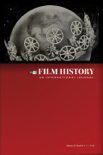
Film History
Navigating the evolution of cinema through a historical lens.Film History, published by Indiana University Press, is a premier academic journal that delves into the evolving landscape of cinema, illuminating the intricate interplay between historical narratives and film culture. With ISSN 0892-2160, and E-ISSN 1553-3905, this journal has established itself as a crucial resource for researchers, professionals, and students in the fields of history and visual arts. Recognized in the Q2 category for both History and Visual Arts and Performing Arts as of 2023, it boasts impressive Scopus rankings, securing #152 out of 667 in Visual Arts and Performing Arts, and #524 out of 1760 in History, placing it in the top 30th percentile. Although it does not currently offer open access options, the journal provides a wealth of scholarly articles that critically engage with film as a historical text, fostering a deeper understanding of its role in shaping societal narratives. Since its inception in 1987, Film History has been at the forefront of academic discourse, making it an invaluable resource for those seeking to explore the rich tapestry of cinematic history.
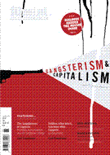
Film International
Unveiling the Social Significance of Cinematic Art.Film International is a prominent journal dedicated to the exploration of film and its cultural, social, and artistic significance. Published by INTELLECT LTD, this journal serves as a platform for interdisciplinary studies in the field of film criticism, theory, and scholarship, contributing valuable insights from both established and emerging researchers. With an ISSN of 1651-6826 and an E-ISSN of 2040-3801, the journal is an essential resource for those engaged in the realms of communication, cultural studies, and visual arts, though it is currently classified in the lower quartiles of these fields (Q4). Noteworthy for its critical perspectives and diverse content, Film International enhances the dialogue surrounding cinematic practices and their impact on society. Researchers, professionals, and students can explore its rich assemblage of articles and reviews that reflect the evolving landscape of film studies, making it a significant addition to the academic community focused on the art of film.

Studies in Russian and Soviet Cinema
Transforming Perspectives on Visual Arts and CommunicationStudies in Russian and Soviet Cinema, published by Routledge Journals, Taylor & Francis Ltd, provides a critical forum for the exploration and analysis of cinematic practices, histories, and cultures from the Russian and Soviet eras. With its ISSN 1750-3132 and E-ISSN 1750-3140, this journal operates under the editorial guidance of leading scholars in the field, making significant contributions to the Visual Arts and Performing Arts and Communication categories, where it is ranked in the upper quartiles of its peer group. The journal spans a rich period of study, converging insights from 2006 to 2024, thereby allowing for an in-depth understanding of the evolution and impact of cinema in societal narratives. Researchers and enthusiasts alike will appreciate its dedication to illuminating the often-neglected cinematic treasures of Russia and the Soviet Union, promoting scholarly discourse through its rigorous analyses and diverse range of articles. This journal serves as an essential resource for anyone interested in the intersections of film, culture, and history.